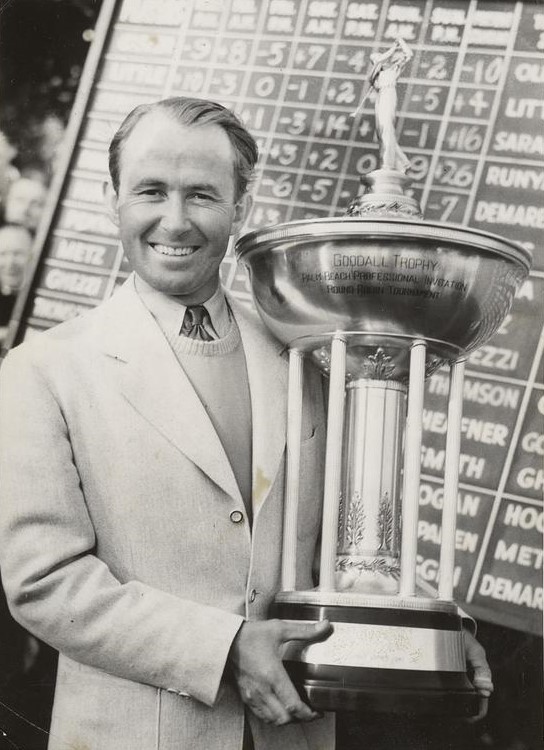
Paul Runyan was born on July 12, 1908, in Hot Springs, Arkansas. He learned to play golf as a caddy at the country club across the way from his father’s dairy farm. He was only 5 feet 71/2 inches tall and weighed 132 pounds. His father did not approve of golf, saying that it was frivolous, but Paul said, “Dad, you can whip me if you want but it won’t do you any good, because I’m going over to the golf course and I’m going to become a golf professional.” Generally out-driven by his opponents, he was a masterful iron player and putter. His superb short game and small stature led to his nickname of “Little Poison”.
By the age of 18, he had become the head Professional at the Concordia Golf and Country Club in Little Rock. A few years later he was Assistant Golf Pro at the Forest Hall Field Club in Bloomfield New Jersey, under Craig Wood. But it was not the right place for him. He wrote,
“Anyway, it wasn’t the kind of place where I could get the opportunity I got at the Metropolis Country Club in White Plains, New York. I was offered the job as head Pro by Mr. Gerald Rosenberger. One night he had me and my wife come to his house in New York, at 865 Park Avenue, for an interview with the Club Board. Everyone was there in black tie – they had had a dinner and I was very impressed. They agreed to take me on at $7,500 a year guaranteed, and anything I made over that was mine. It was a great break because Metropolis was the highest-grade establishment I had ever worked at. It was the way they ran it. Mr. Edwin Waterman ran the place like a czar. He was President of the Club for the fourteen years I was there, and he guided me into becoming a good golf professional…. He said I wasn’t to call any of the members by their first name until they insisted on it. Mr. Rosenberger was the first to insist on it…. After finishing my very first season at Metropolis, Gerald Rosenberger and seventy of the members put up $50 each – a pot of $3,500 – to send me and my wife on the winter tour. They drew up an agreement that I was to send any checks I won back to them and if there were any profits we would split them 50-50. Anyway, the members of Metropolis put up the $3,500, which was a little more than enough to pay for our whole expense, because you got a train ticket from New York to Florida to Southern California to Northern California back down to Southern California, then through Arizona, Texas, and Louisiana back to Florida and up to New York for $202. There was berthage, of course, that was extra. You paid about $8.00 a night for a berth, but it was overall a very reasonable rate."
“Well, that first full winter tour I won about $4,700. I figured, pretty nice, made my winter expenses and lived quite well, didn’t have to spend any of the pennies I saved during the summer, and got fifty percent of the purse money I won – another $2,200 or so. When I got back home, nothing was said by the members, and they had a dinner party for me; the whole membership was there and me and wife were wined and dined, and they didn’t take their share of the profits. They gave me my share, plus a nice big check, which I’ve still got, cancelled, for $1,500. They did the same thing the next winter. They didn’t give me any more bonus, but all the profits. But I was pretty well established by now, and beginning to make some money, maybe $14,000 a year, which was darn good in the depths of the Depression.”
The 1938 PGA Championship was played at the Shawnee Country Club in Shawnee on the Delaware in Pennsylvania. Runyan was a heavy underdog against the favorite, Sam Snead. Snead out-drove Runyan 40 to 50 yards a hole. But Snead’s approach shots were erratic and he had trouble on the greens. In one of the major upsets of all time, Runyon went on to beat Snead by a margin of 8 and 7. Runyon lost only one hole. Snead said, “on the drives, Runyon would be so far behind I’d lose sight of him at times; on second shots, I’d still be far inside him, and then he’d beat me into the hole. He’d sink a shot from behind a bush or chip dead to the cup from a gully or make a pitching iron recovery from a bunker that I’d bet 50 – 1 against.”
“This isn’t golf, it’s magic,” Snead told Runyan.
Runyan won 29 PGA Tour events; was the leading money winner in 1933 and 1934; and was later elected to the PGA Hall of Fame. In 1961 and again in 1962 he won the PGA Senior Championship. In 1998, he won the PGA of America Distinguished Service Award.
Sixty years after his stunning triumph over Snead at the PGA Championship, Runyan, at 90 years of age, shot a 42 for nine holes. Afterwards he said, “I can still have a terrible game and beat my age.” Paul Runyan died at 93 in 2001.